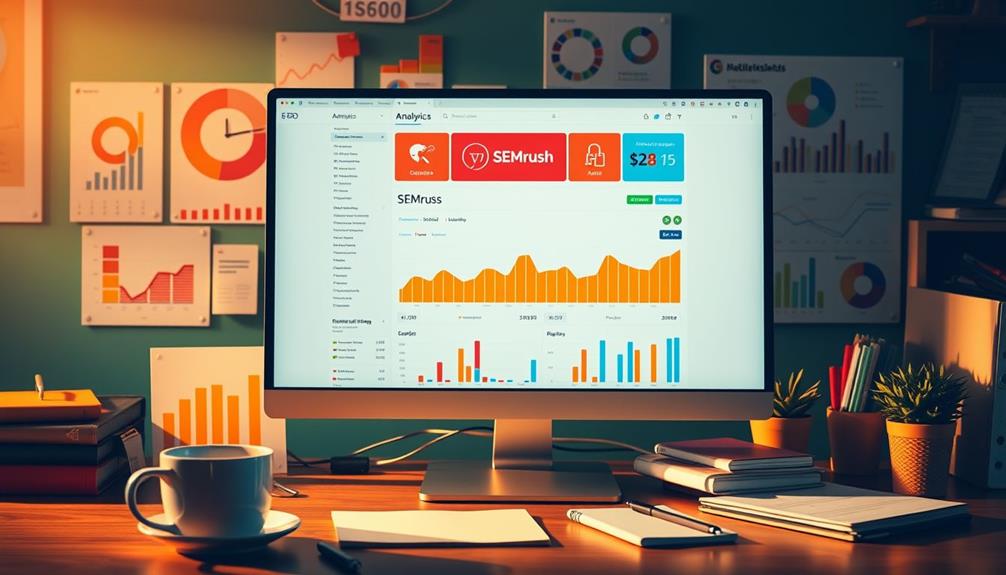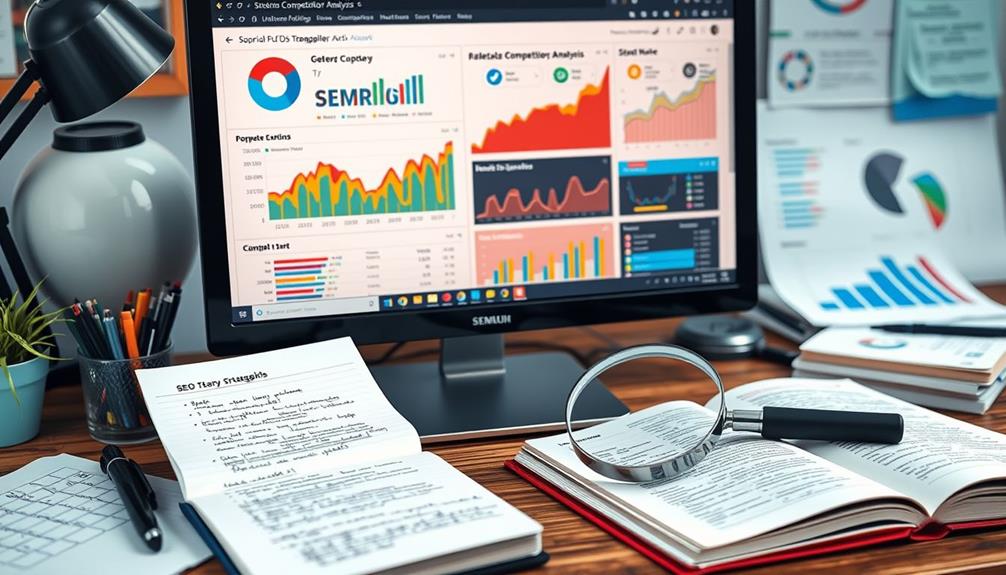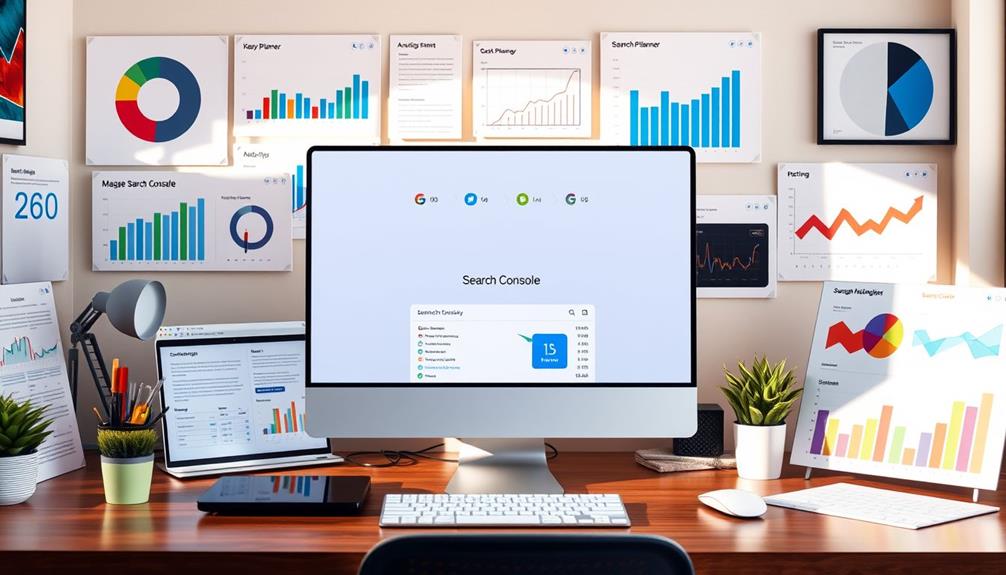Holistic SEO
Unlocking Potential: Explore Linked Data and SEO Today!

In today’s digital age, visibility is crucial for business triumph. Search Engine Optimization (SEO) is a powerful strategy to enhance your website’s visibility and ranking in search engine results. Utilizing both Linked Data and SEO is vital since technologies related to the semantic web and structured data can significantly boost your site’s optimization. By implementing linked data techniques and prioritizing SEO, you position yourself to maximize your digital presence and elevate your business to unprecedented levels.
Key Takeaways:
- Linked Data and SEO work together to improve website visibility and search rankings.
- The semantic web and structured data enhance website optimization.
- Implementing linked data techniques maximizes your online presence’s potential.
- Prioritizing SEO helps drive business success and growth.
- By combining Linked Data and SEO strategies, you gain a competitive edge in the digital landscape.
Understanding SEO: What is Search Engine Optimization?
Search Engine Optimization (SEO) is a fundamental practice in the world of online marketing. It involves optimizing your website to improve its visibility and rankings in organic search engine results. With SEO, you can attract more organic traffic, increase your website’s authority, and ultimately drive business growth.
When users search for information on search engines like Google and Bing, they are presented with a list of results known as the search engine results pages (SERPs). The websites that appear at the top of these results are typically the most optimized and relevant to the user’s search query.
By implementing effective SEO strategies, you can improve your website’s chances of appearing higher in the SERPs, leading to increased visibility and organic traffic. This involves various techniques such as optimizing your website’s structure and content, targeting relevant keywords, improving user experience, and building high-quality backlinks to your site.
The Importance of SEO for Businesses
In today’s digital landscape, SEO is essential for businesses looking to thrive online. With the ever-increasing competition, it is crucial for companies to prioritize their online presence and ensure maximum visibility. SEO, or Search Engine Optimization, plays a vital role in achieving this goal.
One of the key benefits of SEO for businesses is improving brand visibility and awareness. By implementing effective SEO strategies, businesses can enhance their website’s ranking in search engine results, making it more visible to potential customers. Increased visibility leads to higher brand awareness, helping businesses stay top-of-mind for their target audience.
SEO can also drive quality traffic to a business website. By targeting relevant keywords and optimizing website content, businesses can attract users who are actively searching for products or services in their industry. This targeted traffic increases the chances of converting visitors into customers, ultimately boosting conversion rates and driving business growth.
Furthermore, SEO improves the user experience on a website. When a website is optimized for search engines, it also becomes more user-friendly. This leads to better navigation, faster page load times, and an overall enhanced user experience. By providing a seamless browsing experience, businesses can build trust with their audience and encourage repeat visits, ultimately contributing to their competitive edge.

The Importance of Brand Visibility and Awareness
Effective SEO strategies ensure that businesses are visible to their target audience. By ranking higher in search engine results, businesses can increase their brand visibility and awareness. This heightened visibility helps businesses stay ahead of their competition and establish themselves as industry leaders.
Driving Quality Traffic and Increasing Conversion Rates
SEO brings in quality traffic by targeting relevant keywords and optimizing website content. By attracting users who are actively searching for products or services, businesses can increase their chances of converting visitors into customers. This, in turn, leads to higher conversion rates and overall business growth.
Enhancing User Experience and Gaining a Competitive Edge
Optimizing a website for search engines also means improving the user experience. When a website is easy to navigate, loads quickly, and provides valuable information, users are more likely to engage with the brand. By enhancing the user experience, businesses can build trust with their audience, encourage repeat visits, and gain a competitive edge in their industry.
How SEO Works: The Mechanics Behind Search Engines
Understanding the mechanics behind search engines is key to unlocking the potential of SEO. Search engines use a process called crawling to discover and analyze web pages. They start with a list of known URLs and follow links on those pages to find new ones. When a search engine crawls a webpage, it analyzes its content and stores information about it in a database called an index.
Indexing is the process of organizing and storing web pages so they can be retrieved quickly and efficiently when someone performs a search. The search engine’s index consists of all the information it has collected about web pages, including the words on the page, the links on the page, and how the page is structured. This data is used to determine the relevance of a webpage to a search query.
Ranking is the final step in the process. Search engines use complex algorithms to analyze the information in their index and determine the order in which web pages should appear in search results. These algorithms take into account hundreds of different factors, including keyword relevance, website quality, and user experience. The goal of these algorithms is to provide the most relevant and useful results to search engine users.
| Search Engine | Crawling | Indexing | Ranking |
|---|---|---|---|
| Crawls web pages using Googlebot | Stores web page information in the Google index | Uses complex algorithms to determine search rankings | |
| Bing | Crawls web pages using Bingbot | Stores web page information in the Bing index | Uses algorithms to determine search rankings |
| Yahoo | Crawls web pages using Yahoo Slurp | Stores web page information in the Yahoo index | Uses algorithms to determine search rankings |
“Search engines are like librarians organizing the vast collection of information on the internet. They crawl through the web, indexing pages, and ranking them based on relevance and quality. Understanding how search engines work is crucial to optimizing your website for maximum visibility and success.”
By having a clear understanding of how search engines work, you can optimize your website to improve its visibility and rankings. Implementing SEO techniques that align with the mechanics of search engines can help you attract more organic traffic and reach your target audience effectively.

The Role of Keywords in SEO
Keywords are a fundamental element of any successful SEO strategy. By conducting thorough keyword research, we can identify the terms and phrases that our target audience uses when searching for information related to our business. These keywords then serve as a bridge between user queries and the content on our website.
Strategic keyword placement is crucial for search engines to understand the relevance and context of our website. By strategically incorporating keywords into our content, headings, meta tags, and URLs, we can improve our website’s visibility and ranking in search results.
When it comes to keyword optimization, it’s essential to focus not only on broad terms but also on long-tail keywords. Long-tail keywords are more specific and less competitive, enabling us to attract more specific and qualified traffic to our site. By targeting these more niche terms, we can increase our chances of connecting with users who are actively seeking the products or services we offer.
Table: Keyword Optimization Checklist
| Steps | Description |
|---|---|
| 1. Conduct keyword research | Identify relevant keywords and search terms that align with your target audience’s interests and search behavior. |
| 2. Analyze keyword competition | Evaluate the competitiveness of your chosen keywords to determine their potential impact on your search rankings. |
| 3. Choose long-tail keywords | Select long-tail keywords that have less competition but are highly relevant to your business and target audience. |
| 4. Place keywords strategically | Strategically incorporate keywords into your website’s content, headings, meta tags, URLs, and image alt text. |
| 5. Optimize content | Create high-quality, informative, and engaging content that naturally incorporates your chosen keywords. |
| 6. Monitor and refine | Regularly monitor your keyword performance and make adjustments as needed to improve your search rankings. |
By following these keyword optimization practices, we can strengthen our SEO efforts, increase our website’s visibility, and attract valuable organic traffic from search engines.
The Basics of Link Profile Optimization
Link profile optimization is a crucial aspect of improving your website’s search engine ranking and authority. By strategically managing your backlinks, you can enhance your online presence and drive organic traffic to your site. Backlinks serve as votes of confidence from other websites, indicating that your content is valuable and trustworthy. A strong link profile helps search engines recognize the relevance and authority of your website, resulting in higher rankings and increased visibility in search results.
Key Components of Link Profile Optimization
When optimizing your link profile, there are several key components to consider:
- Acquiring High-Quality Backlinks: Focus on acquiring backlinks from authoritative and relevant websites in your industry. High-quality backlinks carry more weight and contribute to a stronger link profile.
- Removing Toxic Links: Identify and remove any toxic or spammy links that may harm your website’s reputation. Use tools like Google Search Console to monitor your backlink profile and disavow any harmful links.
- Diversifying Backlink Sources: Aim for a diverse range of backlink sources, including websites, blogs, social media platforms, and directories. This helps demonstrate your website’s authority and relevance across different platforms.
- Analyzing Link Metrics: Use tools like Ahrefs, Moz, or SEMrush to analyze link metrics such as Domain Authority (DA) and Page Authority (PA). These metrics provide insights into the strength and authority of your backlinks.
By focusing on these components, you can optimize your link profile and improve your website’s search engine ranking and authority.
| Benefits of Link Profile Optimization | How it Impacts Your Website |
|---|---|
| Improved Search Engine Ranking | A strong link profile signals to search engines that your website is authoritative and relevant, leading to higher search rankings. |
| Increased Website Authority | By acquiring high-quality backlinks and removing toxic links, your website gains credibility and authority in your industry. |
| Enhanced Organic Visibility | A well-optimized link profile helps your website appear higher in search results, increasing its visibility to potential organic traffic. |
Link profile optimization is an ongoing process that requires regular monitoring and adjustment. By consistently improving and maintaining your link profile, you can maximize your website’s visibility, authority, and search engine rankings.

Assessing Your Link Profile
Assessing your link profile is an essential step in optimizing your website’s SEO performance. By thoroughly evaluating your backlink data, link metrics, and identifying toxic links, you can take proactive steps to improve your link profile and boost your search engine rankings.
There are various tools available, such as Google Search Console, Ahrefs, Moz, and SEMrush, that provide valuable insights into your backlinks. These tools can help you identify the websites linking to yours, the anchor text usage, and the authority of the linking domains.
When analyzing your link profile, it’s important to pay attention to link metrics such as Domain Authority (DA) and Page Authority (PA). These metrics give you an indication of the strength and authority of your backlinks. Higher DA and PA scores suggest that the linking domains have established authority and can positively influence your own website’s authority and visibility.
| Link Metrics | Definition |
|---|---|
| Domain Authority (DA) | A score (ranging from 0 to 100) that predicts how well a website will rank on search engine result pages. |
| Page Authority (PA) | A score (ranging from 0 to 100) that predicts how well a specific page on a website will rank on search engine result pages. |
In addition to evaluating the overall quality of your backlinks, it’s crucial to identify and handle toxic links. Toxic links are backlinks from spammy or low-quality websites that can have a negative impact on your website’s reputation and rankings. Disavowing or removing these toxic links is essential to maintain a healthy link profile and protect your website’s SEO performance.

Key Takeaways:
- Assessing your link profile is crucial for optimizing your website’s SEO performance.
- Tools like Google Search Console, Ahrefs, Moz, and SEMrush provide valuable data on backlinks and link metrics.
- Evaluating link metrics like Domain Authority (DA) and Page Authority (PA) helps determine the strength and authority of your backlinks.
- Identifying and handling toxic links is essential to maintain a healthy link profile and protect your website’s SEO.
Strategies for Link Profile Optimization
Optimizing your link profile is crucial for improving your website’s visibility, authority, and rankings in search results. By implementing effective link profile optimization strategies, you can enhance the quality and quantity of your backlinks. Here are some key strategies to consider:
- Diversifying Backlink Sources: Acquiring backlinks from various platforms, such as reputable websites, blogs, social media, and directories, signals authority and enhances your website’s visibility.
- Anchor Text Variation: Balancing the variation of anchor text used in your backlinks helps search engines understand the relevance and context of your website. Avoid over-optimization and focus on natural, diverse anchor text.
- Building High-Quality Backlinks Organically: Instead of resorting to manipulative link-building tactics, focus on creating valuable content that naturally attracts high-quality backlinks from authoritative sources.
- Utilizing Guest Posting and Content Marketing: Engaging in guest posting and content marketing initiatives allows you to reach wider audiences, build relationships with other websites, and earn valuable backlinks.
By implementing these strategies consistently and ethically, you can optimize your link profile and improve your website’s visibility, authority, and rankings in search results.
Table: Link Profile Optimization Strategies
| Strategy | Description |
|---|---|
| Diversifying Backlink Sources | Acquire backlinks from various platforms, such as reputable websites, blogs, social media, and directories. |
| Anchor Text Variation | Balancing the variation of anchor text used in your backlinks helps search engines understand the relevance and context of your website. |
| Building High-Quality Backlinks Organically | Create valuable content that naturally attracts high-quality backlinks from authoritative sources. |
| Utilizing Guest Posting and Content Marketing | Engage in guest posting and content marketing initiatives to reach wider audiences and earn valuable backlinks. |
By following these link profile optimization strategies, you can strengthen your website’s link profile, improve search engine rankings, and ultimately drive more organic traffic to your site.

Exploring Backlink Quantity for Ranking
Backlinks are a fundamental component of search engine optimization (SEO). They are external links that point to your website from other websites. In SEO, backlink quantity plays a crucial role in determining your website’s ranking in search engine results.
Search engines consider backlinks as a vote of confidence from other websites. The more high-quality backlinks you have, the more likely search engines will view your website as authoritative and relevant. However, it’s important to note that backlink relevance and quality are equally important in addition to backlink quantity.
While having a large quantity of backlinks can be beneficial, it is also essential to consider the relevance of those backlinks. Search engines analyze the context and relevance of the websites linking to your site when determining your search engine ranking. Backlinks from websites that are highly relevant to your industry or niche carry more weight and can boost your website’s visibility in search results.
| Factors | Influence |
|---|---|
| Backlink Quantity | Positive impact if relevant and high-quality |
| Backlink Relevance | Highly influential in search engine rankings |
| Competition | Consider competition for target keywords |
| Search Algorithms | Constantly evolving to evaluate backlink quality and relevance |
When evaluating the quantity of backlinks, it’s important to analyze the competition in your industry. If your competitors have a large number of high-quality backlinks, it may be necessary to acquire a similar quantity to remain competitive. However, keep in mind that quality and relevance are vital for long-term SEO success.
Striking the Balance: Quality vs. Quantity of Backlinks
When it comes to backlinks, finding the right balance between quality and quantity is essential for a successful SEO strategy. While quality backlinks from authoritative and reputable websites are crucial for signaling to search engines that your content is valuable and trustworthy, having a reasonable quantity of diverse, high-quality backlinks is equally important for establishing website authority and relevance. It’s not just about having as many backlinks as possible, but about ensuring that they are relevant and of high quality.
A balanced backlink strategy focuses on acquiring both quality and quantity. Quality backlinks are those that come from reputable websites in your industry or niche. These backlinks carry more weight and have a stronger impact on your website’s authority and visibility. On the other hand, quantity is important for demonstrating to search engines that your website is well-connected and popular among other sites. By striking the right balance between quality and quantity, you can improve your search engine rankings and enhance your online credibility.
“A balanced backlink strategy is like building a strong foundation for your website. Quality backlinks serve as pillars, while quantity creates a broader network of connections. Together, they form the backbone of your search engine optimization efforts.”
Website authority is a crucial factor in search engine ranking algorithms. Search engines consider websites with a strong and diverse backlink profile to be more authoritative and relevant. Having high-quality backlinks signals to search engines that your website offers valuable and trustworthy content, while having a reasonable quantity of backlinks shows that your website is well-connected and popular among other sites. The right balance of quality and quantity is key to establishing and maintaining website authority, which directly impacts your search rankings and organic visibility.
Table 10: Quality vs. Quantity of Backlinks
| Quality Backlinks | Quantity of Backlinks |
|---|---|
| From authoritative and reputable websites | A reasonable quantity of diverse backlinks |
| Signal content value and trustworthiness | Demonstrate website popularity and connectivity |
| Improve website authority and relevance | Enhance search engine rankings |
Remember, a successful backlink strategy is not just about the number of backlinks you have, but also about the quality and relevance of those backlinks. By focusing on generating quality backlinks from authoritative sources while also maintaining a reasonable quantity of diverse backlinks, you can strike the ideal balance and improve your website’s authority, relevance, and search engine rankings.
Topic Clusters: Organizing Content for SEO Success
When it comes to SEO, one of the most effective strategies you can implement is organizing your content using topic clusters. Topic clusters involve grouping related subjects together, with a pillar post serving as the central topic, and subtopic clusters providing more specific information. This approach not only improves the organization of your website but also enhances your site’s authority and helps search engines understand the context of your content.
One key element of topic clusters is the use of internal links. By linking your pillar post to the subtopic clusters and vice versa, you create a cohesive structure that search engines can easily navigate. These internal links also help visitors to your site explore related content, improving their user experience and increasing the likelihood of engagement and conversions.
Implementing topic clusters can have several benefits for your website. Firstly, it improves site authority by demonstrating expertise in a particular subject area. When search engines see that your website has in-depth and comprehensive content on a specific topic, they are more likely to rank it higher in search results. Additionally, topic clusters provide contextual understanding for search engines, allowing them to better identify the relevance of your content to specific search queries.
Overall, organizing your content into topic clusters is an effective SEO strategy that can enhance your website’s visibility, improve user experience, and ultimately drive organic traffic. By implementing internal links and creating comprehensive, interconnected content, you can position your website as a valuable resource and increase your chances of ranking higher in search results.
The Benefits of Topic Clusters:
- Improved site authority
- Enhanced contextual understanding for search engines
- Increased organic visibility
- Enhanced user experience
Steps to Creating Topic Clusters:
- Identify your pillar content: Choose a broad topic that you want to rank for.
- Create subtopic clusters: Brainstorm related subtopics that provide more specific information.
- Develop comprehensive content: Write pillar posts and subtopic cluster articles that provide valuable insights.
- Integrate internal links: Link your pillar post and subtopic cluster articles using relevant anchor text to create a cohesive structure.
Example of a Topic Cluster:
| Pillar Post | Subtopic Clusters |
|---|---|
| Effective Content Marketing Strategies | 1. How to Create Engaging Blog Posts |
| 2. The Power of Video Marketing | |
| 3. Leveraging Social Media for Content Promotion |
Anatomy of a Topic Cluster
In order to implement an effective topic cluster strategy, it is important to understand the essential components that make up a topic cluster. A topic cluster consists of three main elements: the pillar post, cluster content, and internal links.
The pillar post serves as the core topic of the cluster and provides a comprehensive and in-depth exploration of a particular subject. This pillar post should be well-researched and cover the topic from various angles, providing valuable insights and information to the reader. It should be a comprehensive piece of content that stands on its own and is highly optimized for search engines.
The cluster content, on the other hand, focuses on specific subtopics related to the pillar post. These subtopics delve deeper into specific aspects of the core topic, providing targeted analyses or insights. Each cluster content piece should be linked back to the pillar post, creating a cohesive structure within the topic cluster.
To further strengthen the topic cluster, internal links are used to connect the pillar post and cluster content. Internal links help search engines understand the relationship between the pieces of content within the cluster and enhance the overall authority of the topic cluster. These internal links also provide a seamless user experience, allowing visitors to navigate through the cluster content easily.
Conclusion
At Linked Data SEO, we believe that the combination of Linked Data and SEO is the key to unlocking your website’s full potential. By implementing semantic web techniques and optimizing your site for search engines, you can achieve improved visibility and enhanced search rankings. The success of your SEO efforts can ultimately lead to business growth and increased success.
With our guidance and the strategies outlined in this article, you can take advantage of the power of Linked Data and SEO to propel your website to new heights. By improving your visibility in search results and attracting more organic traffic, you can expand your reach and connect with a wider audience.
By prioritizing SEO and implementing the techniques discussed in this article, you can improve your website’s visibility, enhance your search rankings, and ultimately drive business growth. Don’t miss out on the opportunity to unlock your website’s full potential with Linked Data and SEO. Start implementing these strategies today and see the difference it can make for your online presence.
FAQ
What is Search Engine Optimization (SEO)?
SEO is the practice of optimizing your website to improve its visibility and rankings in organic search engine results. It involves strategies and techniques to make your website more appealing to search engines like Google and Bing. When your site is optimized, it appears higher on search engine results pages, leading to increased visibility and more organic traffic.
Why is SEO important for businesses?
SEO is essential for businesses because it enhances brand visibility and awareness by helping your website rank higher in search results. By driving quality traffic to your site, SEO increases your chances of attracting potential customers who are already interested in your offerings. SEO also improves conversion rates by building trust with users and making your website more user-friendly. Additionally, SEO provides a competitive edge by positioning your brand above competitors in search rankings.
How does SEO work?
SEO works by leveraging the mechanics of search engines. Search engines crawl and index websites to gather data and understand their content. They rank websites based on various factors, including relevance to search queries, website quality, and user experience. Algorithms play a crucial role in determining search rankings, constantly evolving to improve the user experience. By understanding how search engines work, you can optimize your website to improve its visibility and rankings.
What are keywords and how do they impact SEO?
Keywords are specific terms and phrases that users type into search engines when looking for information. Keywords play a vital role in SEO as they bridge the gap between user queries and your website’s content. By conducting keyword research, you can identify the popular terms and phrases that your target audience uses when searching for information related to your business. Strategic keyword placement and optimization within your content help search engines understand the relevance and context of your website. Utilizing long-tail keywords can attract more specific and qualified traffic to your site.
How does backlink optimization affect SEO?
Backlink optimization, also known as link profile optimization, focuses on managing the network of backlinks that lead to your website. Your link profile, which is the collective makeup of all your backlinks, provides search engines with insights into your website’s authority and relevance. A strong link profile can positively impact your search engine rankings, while a poor or spammy link profile can lead to penalties. By optimizing your link profile through strategic backlink acquisition, you can improve your website’s authority, visibility, and search rankings.
How can I assess and optimize my link profile?
Assessing your link profile is essential to understand the strength and weaknesses of your backlink portfolio. Tools like Google Search Console, Ahrefs, Moz, and SEMrush can provide valuable data on your backlinks, including the websites linking to yours, anchor text usage, and linking domain authority. Analyzing link metrics such as Domain Authority (DA) and Page Authority (PA) helps determine the strength and authority of your backlinks. Identifying and handling toxic links is crucial to maintaining a healthy link profile, and disavowing or removing them can protect your website’s reputation and rankings.
How many backlinks do I need for SEO success?
The ideal quantity of backlinks varies depending on various factors, such as your niche, competition, and target keywords. While quality is important, having a reasonable quantity of high-quality, relevant backlinks can positively influence your search engine rankings. It is important to consider backlink quantity in conjunction with backlink quality and relevance. Search engine algorithms analyze a wide range of factors beyond backlink quantity, including content quality, user experience, and on-page optimization.
What is the balance between quality and quantity of backlinks?
Finding the right balance between quality and quantity of backlinks is essential. Quality backlinks, from authoritative and reputable websites, signal to search engines that your content is valuable and trustworthy. However, having a reasonable quantity of diverse, high-quality backlinks is also important for establishing website authority and relevance. Balancing both quality and quantity in your backlink strategy can improve search rankings and enhance your online credibility. By focusing on generating valuable and authoritative backlinks, you can strike the ideal balance.
What are topic clusters and how do they impact SEO?
Topic clusters are a strategic approach to organizing content for SEO success. They involve categorizing related subjects into distinct containers, with a pillar post as the core topic and related subtopics as clusters. Internal links connect these pieces of content, creating a cohesive structure that search engines can easily understand. Topic clusters enhance site authority, provide contextual understanding for search engines, improve user experience, and increase organic visibility. By utilizing topic clusters, you can optimize your content strategy to improve SEO and user engagement.
What components make up a topic cluster?
A topic cluster consists of three essential components: a pillar post, cluster content, and internal links. The pillar post is a comprehensive, in-depth article that covers a core topic in detail. Cluster content focuses on specific subtopics related to the pillar post and provides targeted analyses or insights. Internal links connect the pillar post and cluster content, creating a cohesive structure. By creating a topic cluster, you enhance your website’s visibility, establish yourself as an authority, and increase keyword visibility in search results.
Holistic SEO
DIY SEO Audit: A Step-by-Step Guide for Non-Technical Users
Improve your website’s performance with our DIY SEO audit guide, and uncover essential strategies that will transform your online presence. Discover more inside!

A DIY SEO audit helps you boost your website's performance without needing technical skills. Start by setting clear goals and gathering data using tools like Google Analytics and Screaming Frog. Next, conduct your audit by checking technical aspects like site speed and mobile-friendliness while optimizing on-page elements like title tags and meta descriptions. Analyze your findings by categorizing issues and prioritizing fixes based on their impact. Finally, implement improvements and monitor your site regularly for a smoother user experience. With these steps, you'll pave the way for better visibility, and there's even more to discover along the way.
Key Takeaways
- Start by defining SMART goals for your SEO audit to clarify what you want to achieve.
- Use user-friendly tools like Google Analytics and Screaming Frog to gather relevant performance data.
- Conduct a site crawl to identify technical issues such as broken links and slow loading times.
- Optimize on-page elements like title tags and meta descriptions for better search visibility.
- Document your findings and create a strategic roadmap for implementing necessary improvements.
Understanding SEO Audits
When you immerse yourself in the world of SEO, understanding SEO audits is essential for your website's success. An SEO audit is a thorough evaluation that looks at your website's performance, visibility, and content quality. By conducting an audit, you'll identify technical issues, on-page errors, and off-page shortcomings that could hinder your search engine rankings.
Regular audits are particularly important as AI advancements raise significant privacy concerns regarding user data management and how it impacts your site's compliance with search engine policies.
Search engines assess your site based on its technical setup and the relevance of your content. This means regular audits are vital to keep your website optimized and adaptable to algorithm changes. It's recommended to perform basic checks quarterly and conduct more detailed evaluations at least once a year. If you make significant changes to your site, consider running an additional audit.
An effective SEO audit acts as a diagnostic tool, revealing strengths and weaknesses in your online presence. With this information, you can create a clear action roadmap to enhance your website visibility and improve organic traffic.
Preparing for Your Audit

Preparing for your SEO audit involves setting clear goals and gathering essential data to confirm an efficient evaluation. Start by defining SMART goals that focus your efforts and outcomes. This will help you stay on track throughout the audit process.
Familiarize yourself with SEO audit tools like Google Analytics to analyze audience behavior and Screaming Frog to identify broken links and metadata issues. Additionally, understanding how dog health and nutrition can impact your site's engagement might provide insights into creating relevant content.
Next, gather the necessary data, including traffic statistics, keyword rankings, and existing site performance metrics. This information provides a solid foundation for your analysis. Create a detailed checklist tailored to your website's structure and content. Verify it covers key areas like technical SEO, on-page optimization, and user experience factors.
Don't overlook the importance of adhering to search engine guidelines. Focus on essential aspects such as mobile-friendliness and page load speed, as these greatly impact overall performance.
Conducting the Audit

To kick off your SEO audit, start by defining clear objectives that will guide your assessment process effectively. Whether you aim to improve website traffic or enhance user experience, having specific goals in mind is essential.
Additionally, implementing keyword clustering and topic clustering can provide a structured approach to understanding which content areas to focus on. Next, utilize free tools like Google Search Console and Google Analytics to gather vital data on site performance, such as organic traffic patterns and indexing status.
Conduct a site crawl using tools like Screaming Frog SEO Spider to identify any technical issues that may hinder your SEO performance. Look for broken links, missing meta tags, and duplicate content.
After addressing these issues, focus on analyzing on-page elements. Optimize your title tags (50-60 characters) and meta descriptions (155-160 characters) for better visibility in search results, while ensuring proper use of header tags to improve content structure.
Analyzing Findings

Analyzing your findings from the SEO audit is essential for pinpointing specific areas that need improvement. Start by categorizing the issues you've identified into technical, on-page, and off-page SEO. This approach helps you focus on the most critical areas. Use tools like Google Analytics and Google Search Console to assess traffic patterns and user engagement metrics, allowing you to understand user behavior on your site.
Here's a quick table to help you organize your findings:
| Issue Type | Actionable Steps |
|---|---|
| Technical SEO | Fix broken links, improve site performance |
| On-page SEO | Optimize content for high-impact keywords |
| Off-page SEO | Enhance backlink strategy |
| User Experience | Improve site navigation and load times |
| User Engagement | Monitor bounce rates and adjust content accordingly |
Prioritize the issues based on their potential impact on rankings and user experience. Focus first on critical technical issues like broken links or slow loading times. Document everything clearly to create a strategic roadmap outlining actionable steps, responsible parties, and timelines for implementing necessary changes.
Implementing Improvements

Implementing improvements based on your SEO audit findings is crucial for boosting your website's performance and visibility. Start by optimizing your site speed; use tools like Google PageSpeed Insights to guarantee your pages load in under 5 seconds. This enhances user experience and can greatly improve your search rankings.
Additionally, incorporating elements that deter potential issues is critical, as seen with the value of home security systems, which highlight the importance of preventative measures.
Next, review your on-page elements. Make certain your title tags are 50-60 characters and meta descriptions are between 155-160 characters. These tweaks can increase your click-through rates and draw more visitors to your site.
Don't forget to monitor for broken links. Regularly check your site for 404 errors, as they can frustrate users and lead to lost traffic. Tools like Screaming Frog can help you identify these broken links efficiently.
Conclusion
Now that you've bravely ventured into the wild world of DIY SEO audits, you might feel like a digital superhero, cape flapping in the virtual wind. You've analyzed, scrutinized, and strategized like a pro! But remember, even superheroes need sidekicks—don't hesitate to call in the experts when the SEO villains get too tricky. So, take a breather, sip that overpriced coffee, and let your website shine brighter than a disco ball at a 70s party!
Chris, SEO and Keywords Expert & Author: Chris lives and breathes SEO. With a deep understanding of keyword research and strategy, he’s our go-to guru for everything related to search rankings. Chris has a knack for identifying trends and opportunities in the SEO world, making him an invaluable asset to our team and our clients.
Holistic SEO
Mastering SEMrush: Unlocking the Full Potential of Your SEO Toolkit
Just when you think you know SEMrush, discover game-changing strategies that can transform your SEO efforts and unlock untapped potential.

Mastering SEMrush can elevate your SEO game considerably. With over 40 tools at your fingertips, you can conduct thorough website audits using the Site Audit Tool to fix technical issues. Leverage the Keyword Magic Tool to find high-traffic, low-competition keywords, and use the Content Marketing Tool for real-time optimization. Analyze your competitors' strategies with the Organic Research and Traffic Analysis tools to identify new opportunities. Regular monitoring of performance metrics helps you stay adaptable. Discovering these strategies can truly reveal SEMrush's potential for your digital marketing efforts. Keep exploring, and you'll uncover even more valuable insights.
Key Takeaways
- Utilize the Keyword Magic Tool for in-depth keyword analysis to identify high-traffic, low-competition opportunities for your SEO strategy.
- Conduct regular website audits with the Site Audit Tool to identify and prioritize technical issues affecting site health and SEO performance.
- Leverage the Content Marketing Tool's SEO Writing Assistant to optimize content in real-time for keyword usage and readability improvements.
- Analyze competitors using the Organic Research and Traffic Analysis tools to uncover their top-performing keywords and ad strategies for informed decision-making.
- Monitor performance metrics with customizable reporting tools to track KPIs like organic traffic and keyword rankings, ensuring continuous optimization.
Overview of SEMrush Tools
SEMrush is like a Swiss Army knife for digital marketers, offering a wide array of tools that streamline various aspects of online strategy. With over 40 SEO tools at your fingertips, you can enhance your PPC, content marketing, and social media efforts seamlessly.
Additionally, effective email marketing strategies can complement your SEO efforts by driving targeted traffic to your site. One standout feature is the Keyword Magic Tool, which helps you discover effective keywords by analyzing search volumes and competition levels. This empowers you to make strategic keyword selections that drive traffic.
The Site Audit tool is another gem, evaluating your website against over 130 technical and SEO checks. It identifies issues that could hinder your site's health and ranking, providing actionable insights to help you improve.
Coupled with its technical SEO capabilities, this feature guarantees your site performs at its best.
Don't overlook the Content Marketing Tool, which includes an SEO Writing Assistant offering real-time feedback to refine your content for search engines.
Plus, you can customize your dashboards to track key metrics like organic traffic and keyword rankings, allowing for focused competitive analysis.
With SEMrush, you're equipped to take your SEO strategies to the next level.
Conducting Website Audits

Conducting regular website audits is essential for maintaining your site's health and guaranteeing ideal SEO performance. By utilizing the Site Audit feature within SEMrush, you can conduct thorough assessments that check for over 130 technical issues that may impact your rankings.
These audits help you identify critical areas like crawl errors, HTTPS implementation, and site speed—key factors in guaranteeing optimal website health and a positive user experience. Additionally, having a methodical approach to these audits mirrors the importance of quality assurance in software development, guaranteeing that your website not only meets industry standards but also provides a reliable experience for users.
After running an audit, SEMrush generates actionable recommendations tailored to your specific needs, allowing you to prioritize issues based on their potential impact on your SEO strategies. Customizing your audit reports enables you to focus on particular aspects of your website, making it easier to track improvements over time.
To stay competitive in search engine rankings, schedule periodic audits—ideally quarterly or after significant site changes. This proactive approach guarantees that you remain ahead of new issues and maintain the effectiveness of your SEO efforts.
Effective Keyword Research

Revealing the potential of effective keyword research can greatly enhance your SEO strategy and drive organic traffic to your site.
With SEMrush's Keyword Magic Tool, you can discover over 5 million keywords, allowing you to pinpoint high-traffic, low-competition options. Start by analyzing keyword difficulty scores, which range from 0 to 100. This helps you prioritize less competitive keywords that boost your chances of ranking higher in search results.
Additionally, implementing keyword clustering can further refine your strategy by organizing related keywords into cohesive topics.
Next, assess the search volume for potential keywords. Higher search volume often correlates with increased visibility and organic traffic when optimized correctly.
Don't forget to utilize the Organic Research tool to analyze your competitors. By evaluating the keywords they rank for, you can uncover opportunities to enhance your own keyword targeting.
Developing Content Strategies

Crafting a solid content strategy is vital for maximizing your SEO efforts and engaging your audience effectively. Start by utilizing the Topic Research tool in SEMrush to generate content ideas based on current trends and audience interests. This helps you create relevant, engaging material that resonates with users.
Additionally, consider incorporating goal tracking tips to refine your content strategy and guarantee that you stay aligned with your overall objectives.
Next, leverage the SEO Writing Assistant to optimize your content in real-time. It'll suggest improvements for keyword usage, readability, and tone, assuring your writing aligns with SEO best practices.
Conduct a thorough Content Audit to evaluate existing content performance. This identifies opportunities for updates or enhancements to boost search rankings and user engagement.
Monitoring keyword performance with the Position Tracking tool is essential. It allows you to adjust your content strategies based on how well your targeted keywords are ranking over time.
Finally, implement strategic keyword selection by using the Keyword Magic Tool to discover high-traffic keywords, focusing particularly on long-tail keywords for better ranking opportunities and precise audience targeting.
Analyzing Competitors

Understanding your competitors is a key part of refining your SEO strategy after developing your content plan. With SEMrush, you can gain valuable insights into your rivals, allowing you to adjust your approach effectively.
A thorough lifestyle approach can also enhance your digital marketing efforts, similar to how holistic lifestyle approach can alleviate menopause symptoms.
Here are some powerful tools to utilize:
- Organic Research tool: Uncover competitors' top-performing keywords, estimated traffic, and their search engine positioning, revealing opportunities for your own strategy.
- Traffic Analysis feature: Get insights into competitors' ad strategies and spending, helping you understand their overall digital marketing approach.
- Backlink Analysis: Evaluate your competitors' backlink profiles to identify high-quality referral sites that can benefit your link-building efforts.
- Position Tracking tool: Regularly monitor competitors' keyword rankings, enabling you to benchmark your performance and adapt your tactics in real-time.
PPC Management Techniques

While effective PPC management can greatly boost your online visibility, mastering the right techniques is essential for maximizing your return on investment. Start by utilizing the Keyword Magic Tool within Semrush to discover profitable PPC keywords. You'll gain insights into search volumes and competition levels, allowing you to target campaigns more effectively.
Additionally, consider the value of budget-friendly vacuum cleaners that can enhance your cleaning routine while saving money.
Next, take advantage of the Ad Builder to streamline your ad creation process. This tool offers customizable templates that align with best practices, ensuring higher click-through rates.
Don't forget the importance of Traffic Analysis; by examining competitor ad strategies, you can assess their estimated ad spend and performance metrics, providing you with valuable insights to refine your own approach.
Regularly track your performance metrics to analyze ROI and campaign effectiveness. Adjust your bidding strategies based on real-time data to optimize results.
Finally, use the Position Tracking tool to monitor keyword rankings over time. This will help you adapt your campaigns to changes in search behavior and competition dynamics, ensuring your PPC efforts remain strong and relevant.
Reporting and Analytics

When it comes to measuring the success of your SEO efforts, having robust reporting and analytics tools is essential. SEMrush provides you with powerful customizable reporting features that integrate seamlessly with Google Analytics, giving you an extensive view of your campaign's performance data.
In today's competitive landscape, understanding the nuances of cybersecurity measures is vital for protecting your digital assets and ensuring your SEO strategies aren't undermined by vulnerabilities.
With SEMrush, you can benefit from:
- Scheduled Reports: Automate report deliveries to stakeholders for consistent communication.
- Data Visualization: Utilize visual tools to easily identify trends and make informed decisions.
- Brand Monitoring: Track online mentions and sentiment to gain insights into your brand's performance.
- Consolidated Dashboard: Access key performance metrics at a glance for quick monitoring.
Continuous Optimization Strategies

To keep your SEO efforts sharp, regularly conduct Site Audits with SEMrush's Site Audit feature to pinpoint issues that could hinder performance.
This is similar to how testimonials enhance credibility in leadership, as it helps in establishing trust with your audience.
By monitoring performance metrics, you can make real-time adjustments that align with user behavior and traffic sources.
This proactive approach guarantees your strategies stay effective and responsive to changing conditions.
Regular Site Audits
Regular site audits are essential for maintaining and enhancing your website's SEO performance, as they uncover critical technical issues that could hinder your success.
By utilizing SEMrush for regular site audits, you can identify over 130 technical and SEO issues, allowing you to prioritize fixes that improve your website health and performance. Incorporating tools and techniques from music production basics can also enhance your approach to website optimization.
Conducting these audits at least quarterly helps you track improvements and discover new issues, ensuring continuous optimization of your SEO strategy.
Here's what you can gain from regular site audits:
- Actionable recommendations based on your audit findings to enhance site speed and overall user experience.
- Customizable audit reports that allow you to focus on critical areas of concern.
- Insights into crawl errors and HTTPS implementation to maintain a user-friendly site structure.
- Continuous monitoring of your website's technical health, ensuring it remains favorable for search engine crawlers.
Performance Metrics Monitoring
Monitoring performance metrics is essential for ensuring your SEO strategies are effective and continuously optimized. By leveraging SEMrush's customizable reporting tools, you can track key performance indicators (KPIs) such as organic traffic, keyword rankings, and backlinks. This gives you an extensive view of your SEO effectiveness.
Understanding the importance of background checks before job offers, for instance, can parallel how you assess your SEO metrics to mitigate risks in your online presence, particularly regarding compliance and credibility in your industry importance of background checks.
Utilize the Position Tracking tool to monitor daily changes in keyword rankings. This enables you to make timely adjustments to your strategies based on performance data.
Conduct periodic Site Audits to identify and rectify over 130 technical issues that may hinder site performance, improving your overall SEO health and user experience.
Integrating Google Analytics with SEMrush offers deeper insights into user behavior and traffic sources, paving the way for data-driven decisions that enhance your optimization strategies.
Don't overlook the Content Audit feature, which evaluates existing content against current SEO practices, ensuring that your website stays relevant and competitive in search engine results.
Conclusion
In summary, mastering SEMrush isn't just a game changer; it's like discovering a secret treasure map for your online success! With these powerful tools at your fingertips, you're not just optimizing your site—you're launching a digital rocket ship straight to the top of search results! So immerse yourself, explore every feature, and watch your traffic soar like never before. The SEO universe is yours to conquer, and SEMrush is your ultimate sidekick!
Chris, SEO and Keywords Expert & Author: Chris lives and breathes SEO. With a deep understanding of keyword research and strategy, he’s our go-to guru for everything related to search rankings. Chris has a knack for identifying trends and opportunities in the SEO world, making him an invaluable asset to our team and our clients.
Holistic SEO
Demystifying Google Search Console: A Comprehensive Guide
Discover how to leverage Google Search Console for your website’s success and unlock essential strategies that could transform your online presence.

Google Search Console is your go-to tool for boosting your website's visibility in search results. It gives you essential metrics like clicks, impressions, and click-through rates, helping you understand user engagement. You can monitor indexing statuses with the URL Inspection Tool and submit sitemaps for better crawl efficiency. Furthermore, you can improve user experience and SEO by optimizing your site's performance. With GSC's insights, you can track keyword performance and enhance content quality. As you explore its features, you'll uncover strategies that can greatly elevate your site's success online. There's a lot more to discover!
Key Takeaways
- Google Search Console (GSC) enhances website visibility by providing essential metrics like clicks, impressions, and CTR for effective traffic analysis.
- The Performance Report and Page Indexing Report help monitor site performance and indexing status, ensuring important pages are discoverable.
- User experience factors, such as mobile-friendliness and site security, significantly impact SEO rankings, as evaluated through Core Web Essentials metrics.
- Utilizing tools like the URL Inspection Tool and Sitemaps Report facilitates efficient indexing and crawling of websites, optimizing search engine performance.
- Regular analysis of keyword performance and content quality through GSC informs strategic adjustments to improve user engagement and search visibility.
Overview of Google Search Console
Google Search Console (GSC) is an invaluable tool for anyone looking to enhance their website's presence in search results. This free platform helps you monitor and optimize your site's performance in Google search, offering essential insights into your websites that are critical for effective SEO.
With GSC, you can track fundamental metrics like clicks, impressions, click-through rates (CTR), and average position, allowing you to assess your search visibility accurately. Utilizing tools like email marketing software selection can complement your SEO efforts by making certain your content reaches the right audience.
One of the standout features is the URL Inspection Tool, which helps you check the indexing status of your pages and identify any visibility issues. By diagnosing crawl errors, you can quickly resolve technical problems that might hinder your site's performance in Google search.
Additionally, GSC monitors site security, alerting you to potential hacking attempts or vulnerabilities, which is key for maintaining your website's integrity.
The Performance Report in GSC provides a thorough overview of how Google interacts with your site, empowering you to make informed decisions for optimization. By leveraging these features, you can greatly enhance your site's SEO and guarantee it ranks better in search results.
Performance and Indexing Reports

When diving into the Performance and Indexing Reports in Google Search Console, you'll uncover essential data that can greatly impact your SEO strategy.
The Performance Report provides key metrics like clicks, impressions, and Click-Through Rate (CTR), enabling effective traffic analysis. Understanding how these elements work together is fundamental for optimizing your site, similar to how protecting your savings is significant when considering investments.
Here are some important aspects to focus on:
- Clicks: The number of times users visit your site from search results.
- Impressions: Counted each time your URL appears in search results.
- CTR: Calculated by dividing clicks by impressions, showing how effective your titles and descriptions are.
- Page Indexing Report: Categorizes your pages into indexed, crawled but not indexed, and excluded statuses.
URL and Sitemap Management Tools

Managing your URLs and sitemaps effectively is vital for optimizing the visibility of your website. Google Search Console offers powerful tools, like the URL Inspection Tool, that provide detailed insights into the indexing status of your individual URLs. You can check the last crawl date and mobile usability metrics, helping you troubleshoot any potential issues.
Additionally, utilizing keyword clustering can enhance the discoverability of your content, making it easier for search engines to index your pages.
When you submit sitemaps through Google Search Console, you help Google discover and index important pages on your site. The Sitemaps Report shows the number of discovered URLs and the status of your submitted sitemaps, allowing you to identify any indexing problems. This way, you can make sure that all notable content is crawled efficiently.
If you've updated content or added new pages, you can utilize the URL Inspection Tool to request indexing. This places your URLs in a priority crawl queue, although immediate indexing isn't guaranteed.
Regularly monitoring the Sitemaps section is essential for evaluating how well Google interacts with your sitemap, making sure all vital pages are included, and revealing discrepancies between expected and discovered URLs. Effective sitemap management can greatly enhance your site's performance in search results.
User Experience and SEO Impact

While many factors influence your site's SEO performance, user experience (UX) has emerged as a crucial element. When you prioritize UX, you directly impact your SEO rankings.
Google evaluates sites based on user experience signals, such as mobile-friendliness and site security, which is essential for maintaining user trust and engagement in today's digital landscape. The importance of value of home security systems in ensuring a safe online environment parallels the need for a secure and accessible website.
To enhance your site's performance, focus on these Core Web Essentials metrics:
- Largest Contentful Paint (LCP): Measures loading performance.
- First Input Delay (FID): Evaluates interactivity.
- Cumulative Layout Shift (CLS): Assesses visual stability.
A positive user experience can lead to improved engagement metrics. Lower bounce rates and increased time on site signal to Google that your content is beneficial, boosting your organic traffic.
The Page Experience Report in Google Search Console is a beneficial tool that helps you assess how well your site meets these UX criteria. By addressing any shortcomings, you can enhance user satisfaction and, consequently, your SEO performance.
Importance of SEO Tools

SEO tools are indispensable for anyone serious about improving their website's performance. Tools like Google Search Console offer essential insights into performance metrics, including clicks, impressions, and click-through rates (CTR). These metrics are essential for boosting your search visibility and guaranteeing that your content reaches the right audience.
Additionally, the integration of AI advancements can enhance your understanding of AI applications in various industries, allowing you to identify trends and optimize your strategies effectively.
By utilizing SEO tools, you can identify and resolve indexing issues that may hinder your site's ability to be crawled and ranked effectively by search engines. This guarantees that your web pages are accessible, which is critical for driving traffic to your site.
Furthermore, the data from these tools can guide your content optimization efforts. You'll discover high-performing keywords and search queries that can improve your content strategy.
Regular monitoring through SEO tools allows you to track the impact of your SEO efforts, making it easier to adapt your strategies based on performance trends and user behavior.
In addition, effective use of these tools can greatly enhance the user experience by evaluating mobile usability and page speed—factors that are increasingly important for both search engine rankings and user engagement.
Optimization Strategies and Benefits

When you use Google Search Console, you can effectively track keyword performance and enhance your content quality.
Implementing a methodical approach to your site structure can greatly improve indexing, ensuring that search engines can easily find and rank your pages. These strategies not only boost your visibility but also improve user engagement, leading to better overall results.
Tracking Keyword Performance
Tracking keyword performance is essential for maximizing your website's visibility and driving organic traffic. Google Search Console (GSC) offers a detailed Performance Report that lets you monitor key metrics like clicks, impressions, and click-through rate (CTR) for specific search queries.
By diving into Search Analytics data, you can uncover high-performing keywords and optimize your content to capture even more organic traffic. A methodical approach to analyzing data is fundamental, and understanding software development lifecycle principles can enhance your overall digital strategy best practices in software quality assurance.
Here are some strategies to enhance your keyword performance tracking:
- Analyze clicks and impressions to understand which keywords are driving traffic.
- Evaluate click-through rates to identify keywords needing content adjustments.
- Monitor trends over time to refine your SEO strategies based on seasonal or market changes.
- Make timely content updates to maintain or improve rankings as search behavior shifts.
Regularly using GSC to track keyword performance helps you stay ahead of the curve, ensuring your content remains relevant and engaging.
This proactive approach is essential for enhancing your site's visibility in search results and maximizing your return on investment in SEO efforts.
Enhancing Content Quality
To improve your website's visibility and user engagement, focusing on content quality is essential. Using Google Search Console (GSC) provides valuable insights for content creators looking to enhance their work. By analyzing the Performance Report, you can discover your average position in search results, guiding you in optimizing existing pages.
Here's a quick overview of the strategies:
| Strategy | Benefit | Tool Used |
|---|---|---|
| Optimize meta titles | Boost click-through rates | GSC Performance Report |
| Enhance content relevance | Align with user intent | GSC Impressions |
| Monitor indexed pages | guarantee content visibility | URL Inspection Tool |
| Adjust based on CTR | Improve underperforming pages | GSC Click-Through Rates |
Improving Site Indexing
Improving site indexing is essential for ensuring that your content reaches its intended audience effectively. By optimizing your site for indexing, you enhance its visibility in search results, which can greatly boost your SEO performance.
Additionally, leveraging the right WordPress features can streamline your content management and improve indexing outcomes. Here's how you can achieve better indexing:
- Submit an XML sitemap: This helps Google crawl and index all important pages on your site efficiently.
- Check the Page Indexing Report: Regularly review this report to identify any non-indexed pages, allowing you to tackle issues that might hinder your site's performance.
- Use the URL Inspection Tool: This tool lets you manually request indexing for updated or new pages, speeding up their appearance in search results.
- Monitor the Coverage report: Address any errors or warnings that could impact your indexing status, enhancing your site's overall visibility.
Conclusion
To sum up, Google Search Console is like a compass guiding you through the vast landscape of SEO. By leveraging its powerful tools and insights, you can enhance your site's performance, improve user experience, and boost your visibility. Don't underestimate the importance of these resources—embracing them can lead to significant growth for your online presence. So, plunge into, explore its features, and watch your website flourish in the search results!
Chris, SEO and Keywords Expert & Author: Chris lives and breathes SEO. With a deep understanding of keyword research and strategy, he’s our go-to guru for everything related to search rankings. Chris has a knack for identifying trends and opportunities in the SEO world, making him an invaluable asset to our team and our clients.
-

 Holistic SEO3 months ago
Holistic SEO3 months agoHolistic Local SEO Tactics for Small Businesses
-

 Holistic SEO3 months ago
Holistic SEO3 months agoHow to Establish Dominance in SEO through Topical Authority
-

 Holistic SEO3 months ago
Holistic SEO3 months agoKeyword Research (SEO) for Tattoo Artists
-

 Learning Center3 months ago
Learning Center3 months ago52 Niches with Good Crossover Potential Explored
-

 Learning Center2 months ago
Learning Center2 months agoThe Future of SEO: Leveraging the Google Search Generative Experience
-

 Holistic SEO3 months ago
Holistic SEO3 months agoHolistic SEO Food Blogger
-

 Keyword Research3 months ago
Keyword Research3 months agoMastering SEO: How to Analyze Keyword Results and Find Easy Keywords
-

 Technical SEO3 months ago
Technical SEO3 months agoUnlock Your Site’s Potential with a Comprehensive Website Audit




















